Using positional rotation is by no means a new concept, with Argentine coach Ricardo La Volpe’s “Salida Lavolpiana” being used to great effect with the Mexican national team in the early-to-mid 2000’s whilst Juego de Posicion has been popularized by the likes of Paco Jémez, Marcelo Bielsa, and Pep Guardiola in more recent years.
It is as simple as players, generally off the ball rather than ball-carriers themselves, swapping with one another in order to move the opposition defenders around, whilst creating space for their team to play the ball forward.
Rather than break it down totally, this tactical analysis and scout report will look at how rotations are used by Atalanta to create overloads and/or attacking chances specifically in wide areas, in order to aid forward play.
With wide areas traditionally only inhabiting two opposition players (a winger, and a full-back), it is, therefore, easier to create overloads in these spaces where it is less crowded, then the centre of the pitch wherein a vertical line we could potentially see seven players at once (one forward, three central-midfielders, two centre-backs, and a goalkeeper, for example). Bringing more players towards the flanks also leaves more space centrally, which is the area where the greatest chance of scoring comes from.
Atalanta
Under Gian Piero Gasperini, Atalanta have been playing some truly electric football, and at the time of the postponement of the Serie A season were sat in fourth-place in the league with a game-in-hand, whilst they had also booked their place in the UEFA Champions League quarter-finals courtesy of an 8-4 drubbing of Valencia over two legs.
At its best, Atalanta’s positional play is the rarest of things; having the appearance of their players improvising with their movements, truly in tune with where their teammates, moving so freely amongst one another, rotating at will. However, the reality is that they have most likely been incredibly well-drilled in this particular phase of the game. Their tactics are based around fielding a 3-4-1-2 formation, with two prolific forwards in Duvan Zapata and Josip Iličić with Papu Gómez sitting in between the forwards and the midfield.
The diamond
One of the key facets of Atalanta’s positional play comes from them positioning four players in a diamond formation, and preferably with the ball-carrier being at the anchor of the diamond, meaning they should have three forward passing options in close proximity.
In the image below we can see Gómez in position at the anchor of the diamond on the left side. Gasperini allows his players to be pretty fluid positionally within the diamond, however, if they do rotate you will most often see Zapata or Iličić rotate with one of the two players closest to them rather than the anchor.
The point of these movements is to free an extra man with speed and fluidity of rotation necessary for success.
Generally, the success comes from the ball-carrier engaging a defender before passing, whilst players not seeking to receive the ball within the diamond will either make decoy runs or work as blockers and help create a crowded area, making it easier for the intended target to lose his marker.
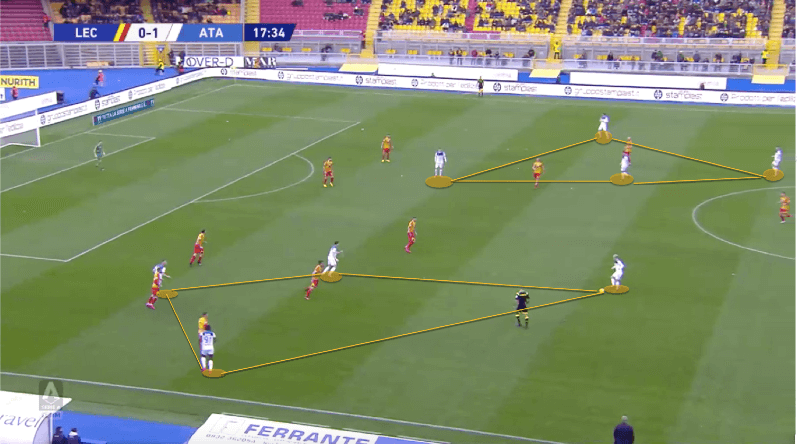
This structure breaks the game down into four v fours. It also means that the ball-carrier should always have three passing options. The opposition defenders,who are marking the three in the diamond who are not in possession, can be moved around through off the ball movement, and this is where spaces can be created to play forward.
The diamond’s make it easy for Atalanta to create space through rotational play. The players are close to one another, and know that their rotations are based on the shape of the diamond. Therefore it gives structure to their rotations.
Where Atalanta truly excel with these diamonds is when they are anchored by one of their three centre-backs, and it allows Gómez the option to drift in the middle of the pitch and rotate into the diamonds to create a 5 v 4 in these areas. From his position as an attacking-midfielder, Gómez should always be available to sustain a forward phase of play by dropping into the diamond where needed.
We see Atalanta frequently use this diamond shape when the ball is in wide areas, regardless of whether the ball is in their own half or the opposition half. Of course, when the ball is in their own half the personnel will change, however, due to Gómez’s positioning they can move up the pitch in these diamonds, as the two images below demonstrate.
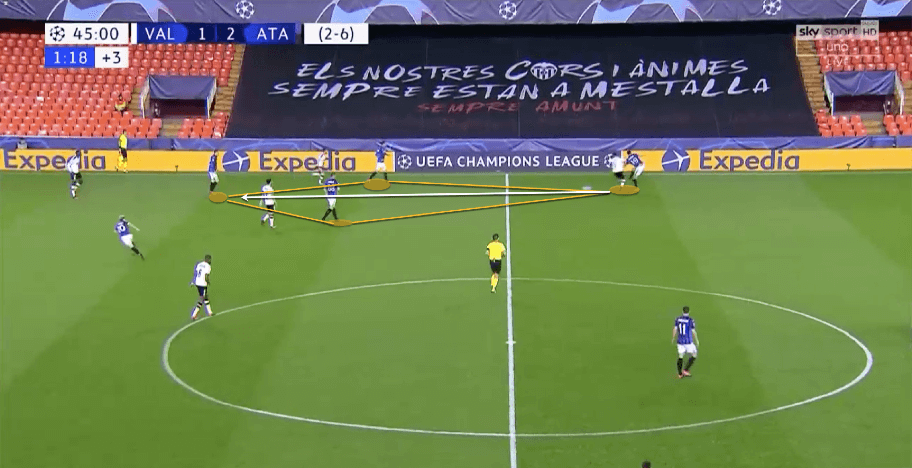
In the above image, Gómez (the closest Atalanta player to the diamond) recognises the forward pass from the centre-back into the feet of the forward, Iličić, at the top of the diamond. He makes his run forward, and as Iličić is now in possession, Gómez has created a new diamond, with himself as the new focal point.
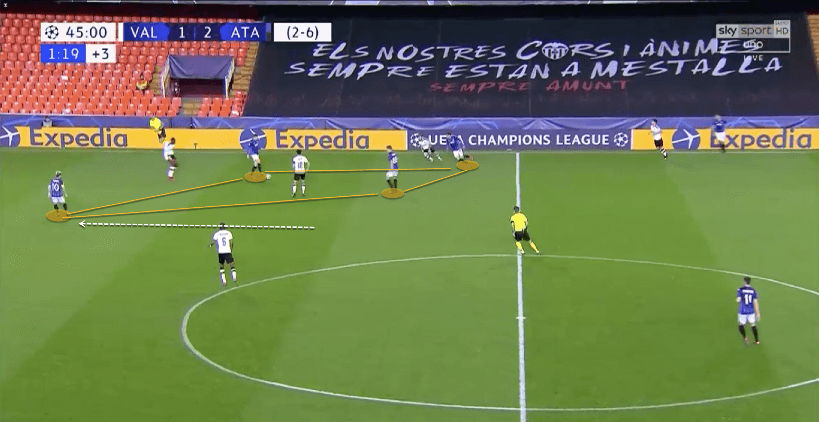
The movement of the centre-forward
As mentioned above, the position of the centre-forward within these diamonds is most often at the top, naturally.
Iličić is a particularly intelligent forward who suits Gasperini’s system perfectly due to his understanding of how to create and exploit space.
Should the centre-forward wish to rotate, their initial movement must bring them away from goal.
Below we see Iličić drop particularly deep to receive the pass from the right-sided centre-back Marten de Roon. For him to receive this pass, Mario Pašalić moves out of the space taking his marker with him, whilst wing-back Hans Hateboer is able to move into the space vacated by Iličić and receive the through pass.
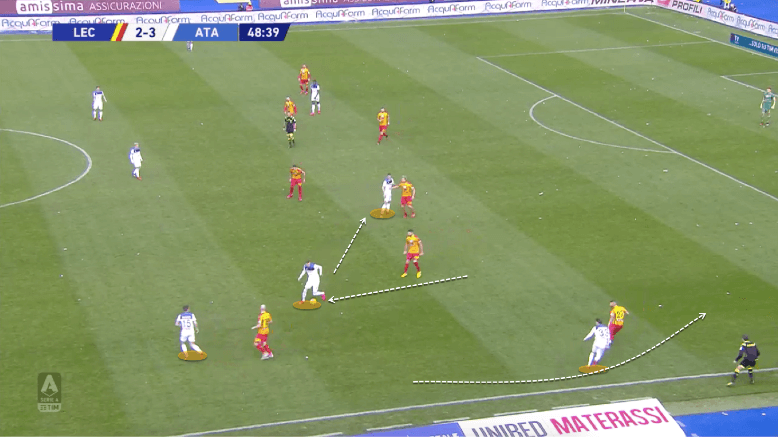
We can see another example of Iličić dropping in to leave space behind him, just five minutes later in the same game. As he does so we can see him point to his teammate Pašalić to complete the rotation and move into the space he has left. Including Iličić, Atalanta have a 4 v 3 in this situation, and it is de Roon’s decision to pass inside to Iličić which allows this rotation to create an effective overload.
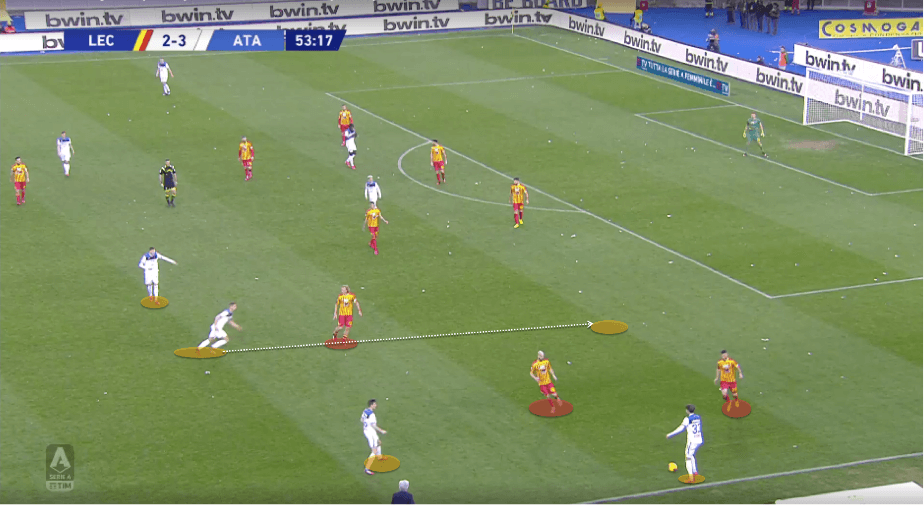
With Iličić receiving the ball he draws the defender in towards him and he has the simple task of playing in Pašalić at the top of the diamond, as the image below shows.
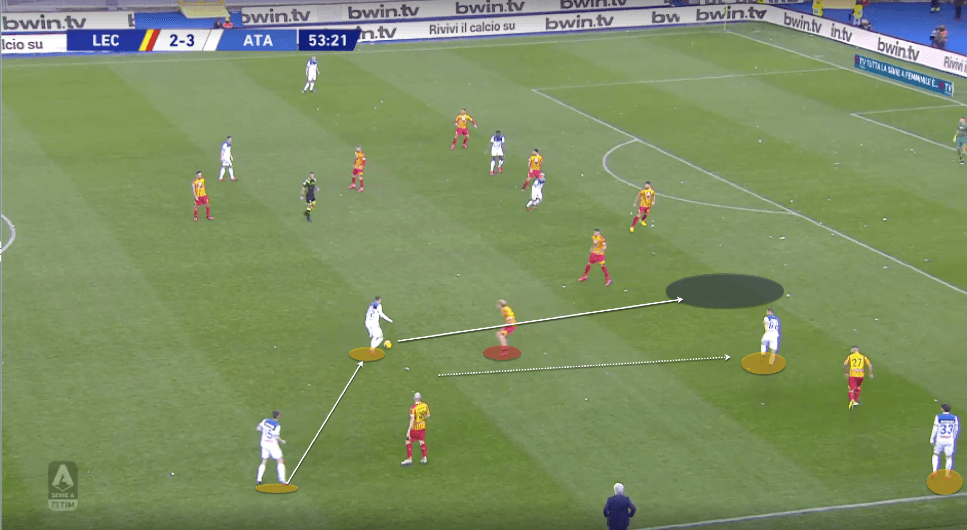
There are often several movements that occur in Atalanta’s diamonds, but all occur with the aim of meeting one of two goals. The first goal is whether they can get a player in possession behind the defence. The second goal is can they work someone, preferably one of their forwards, into a shooting position. If they can achieve both with the same move then excellent, but often it is meeting the first goal, which helps them meet the second.
They demonstrated their ability to free Iličić inside the first two minutes in their Champions League Round of 16 second-leg tie, away at Valencia.
Below we can see three things occur. Firstly Hateboer, the widest of the four highlighted players lays the ball back to de Roon. As he does this, Berat Djimsiti vacates the left side of the diamond, which Hateboer rotates in to, and moves past Iličić to occupy the top of the diamond.
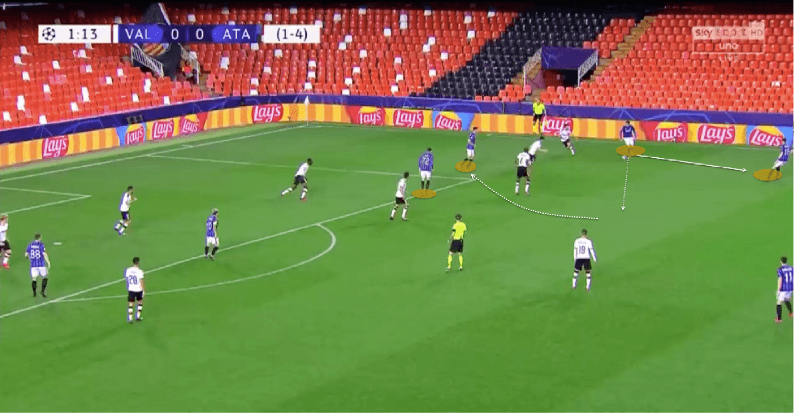
These movements draw the defenders attention towards Hateboer and Djimsiti, a wing-back and a centre-back, hardly Atalanta’s most dangerous attacking options. Iličić is able to loop behind Djimsiti and receive the pass in the space vacated by Hateboer as we can see below.
This move which freed Iličić led to the forward being brought down in the box and Atalanta were able to extend their lead so early on in the game, all coming directly from a series of rotations in Atalanta’s diamond.
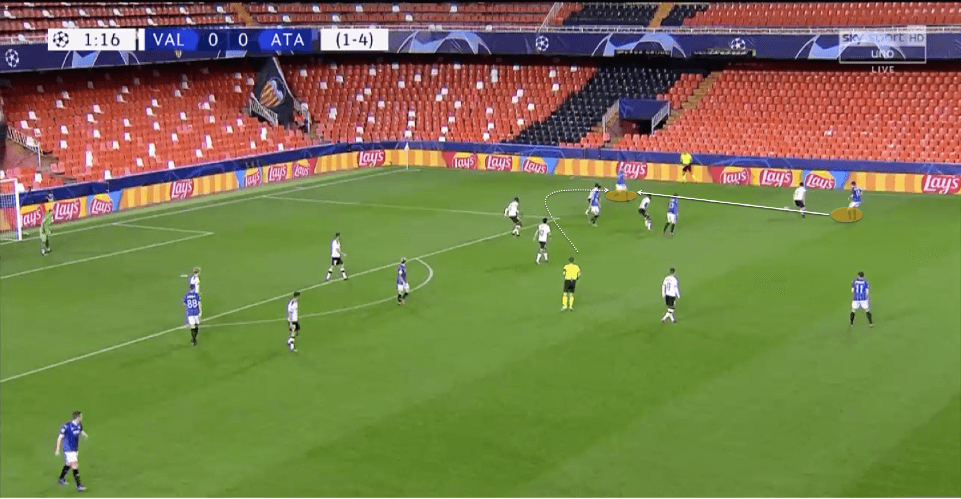
In this scenario the Valencia defence didn’t pay Iličić enough attention, however, the forward is intelligent enough to know when he can release others with his movement, as we saw in the first example against Lecce.
The impact of a fifth player – Gómez
The next example was brought to my attention in an analysis of Atalanta v Roma, by Ian O’Neill, who also writes for Total Football Analysis.
Below we can again see the diamond, but this one is a little different to those we have seen so far. This is the 5 v 4 diamond I mentioned at the beginning of this analysis.
It is important to note the positioning of Gómez who is sitting centrally and is unmarked. Iličić is aware of his teammates positioning and by passing the ball laterally to de Roon, and following the pass after, he is able to create space centrally for Gómez.
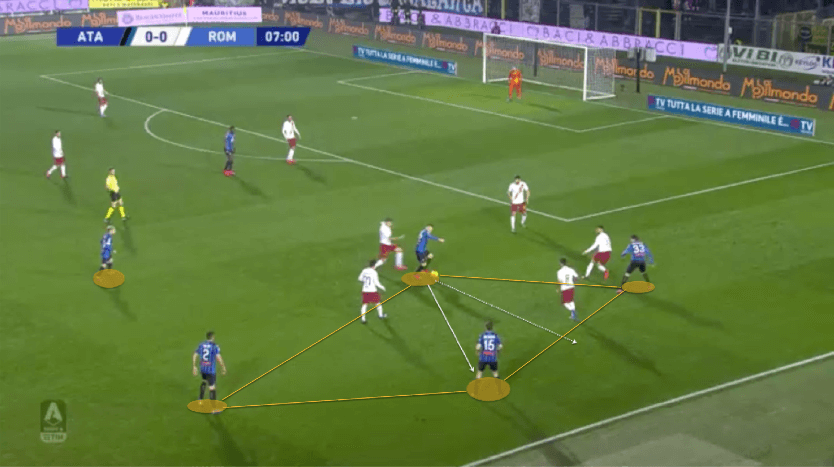
With the defence now focused on Gómez (we can see three Roma defenders focused on the number 10), it leaves Iličić and Hateboer, who was at the top of the diamond, in a potential 2 v 1 situation against the full-back. Gómez is able to slide in the wing-back through the gap, as Hateboer receives the ball behind the Roma defence before making a cross.
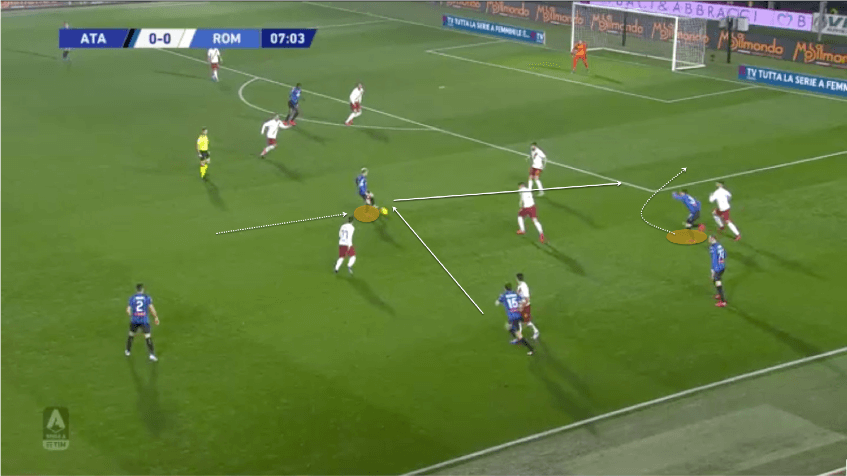
It’s so important to engage an opposition defender when looking to play a pass such as this to open up as much space as possible for the free man.
Conclusion
This analysis has shown how Atalanta have had great success creating attacking chances through rotations in a diamond. It is most often created by a centre-back, wing-back, central-midfielder and centre-forward, and they have players rotate horizontally or vertically. Although it would be unfair to say the pace of these moves is slow (for the ball is often moved swiftly, frequently with one touch), they still take their time to get their diamond set before looking to rotate and create openings.
This is obviously just one way of approaching using rotations to create space behind defences, however, there are certainly some principles that can be transferred to other approaches.
Firstly, using the wide areas to focus these kinds of attacks makes overloads more likely whilst creating space centrally.
Secondly, having a consistent structure, such as the diamond, opens endless possibilities for rotation sequences that can be worked on in training, as well as providing a structure from which players can improvise and have a certain freedom with.
Finally, Atalanta have shown how working on a rotational system which compliments their formation will bring the best results. The image below shows how if either left or right-sided centre-back is in possession of the ball, and are therefore anchoring a diamond, Gómez can use his free role as an attacking midfielder to drop in either side and create overloads.
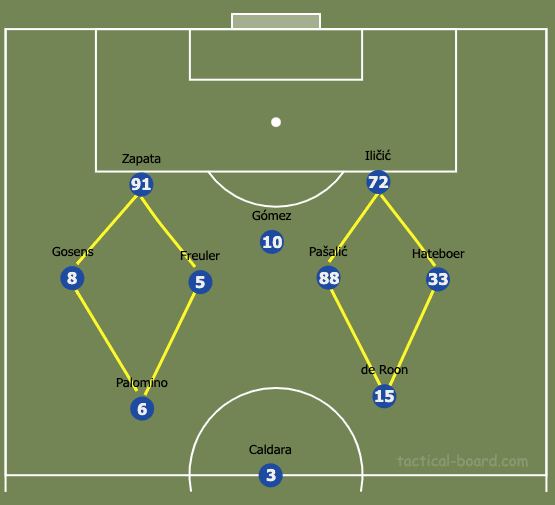




Comments